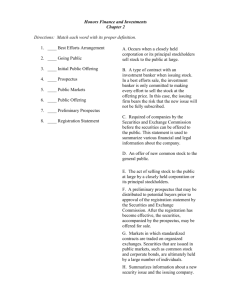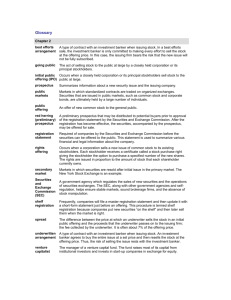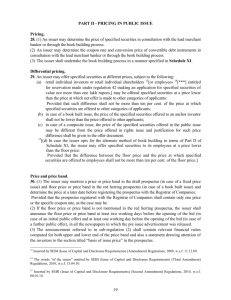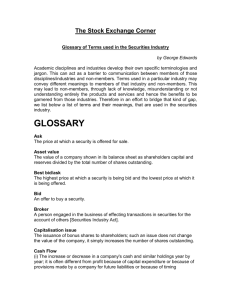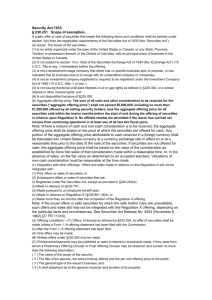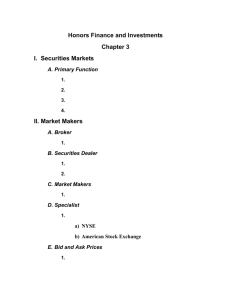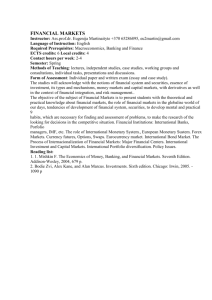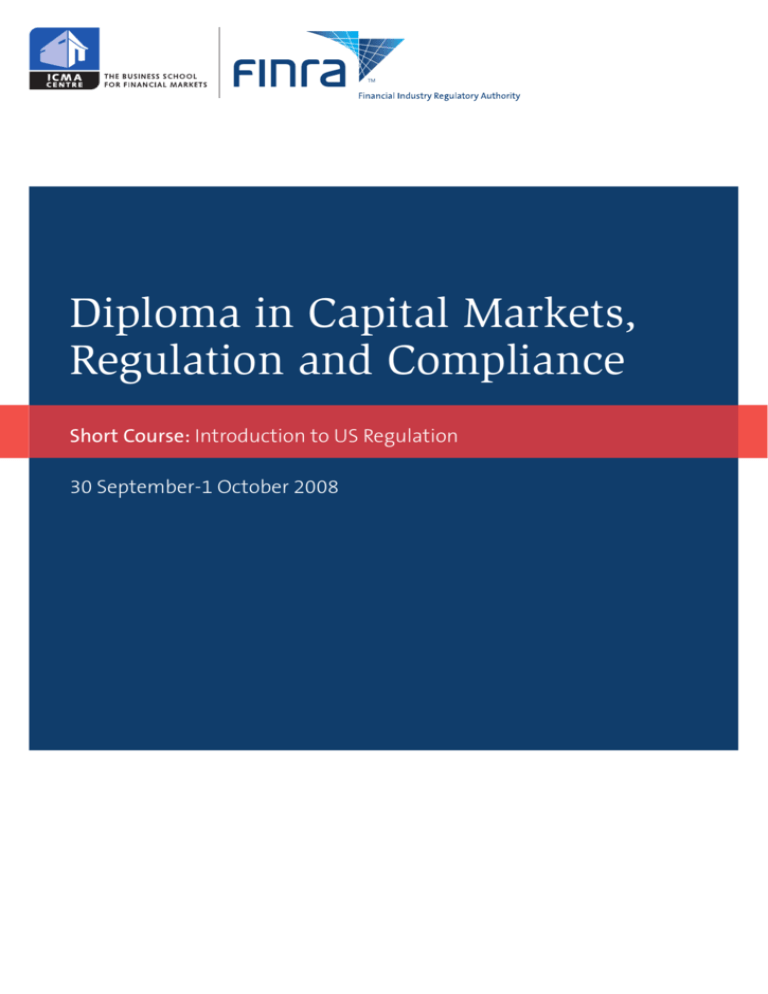
Diploma in Capital Markets,
Regulation and Compliance
Short Course: Introduction to US Regulation
30 September-1 October 2008
Diploma in Capital Markets,
Regulation and Compliance
Short Course: Introduction to US Regulation
The Financial Industry Regulatory Authority (FINRA), University of Reading, and their affiliates
(the “Parties”) are not responsible for any errors in or omissions from the information
contained in this document. All such information is provided “as is” without warranty of any
kind. The Parties make no representations and disclaim all express, implied and statutory
warranties of any kind to the user and/or any third party, including any warranties of
accuracy, timeliness, completeness, merchantability and fitness for any particular purpose.
Unless due to willful tortious misconduct or gross negligence, the Parties shall have no tort,
contract or any other liability to user and/or any third party. Under no circumstance shall
the Parties be liable for any lost profits or lost opportunity, indirect, special, consequential,
incidental or punitive damages whatsoever, even if the Parties have been advised of the
possibility of such damages. The terms of this disclaimer may only be amended in a writing
signed by the Parties.
Copyright © 2007 by FINRA and University of Reading. All rights reserved. No portion of this
document may be duplicated, redistributed, or manipulated in any form.
Securities Act of 1933
There were no federal regulations of securities prior to 1933. Commercial banks were allowed to
deal in securities, credit was loose, and market manipulation was rampant. All this led to the market
crash of 1929. In response, Congress passed the “33 Act that regulated Interstate securities
transactions (including the U.S. mail). The Act required that all Non-Exempt new issues be
registered with the federal government (SEC) by filing a Standard Registration Statement or S-1
(Form S-B1 is an abbreviated form for registered offerings of less than $10MM). Once registered,
a Prospectus must accompany the sale or offer of these securities to provide Full and Fair
Disclosure.
The date an S-1 is filed with the SEC is not surprisingly called the Filing date. Within one
business day of the filing date a copy of the registration statement must also be filed with the
FINRA Committee on Corporate Finance. The Committee on Corporate Finance reviews the
Underwriter Agreements to judge the fairness of the underwriter’s compensation package. This
begs the question; What is unreasonable compensation?
Compensation greater than 10% of gross proceeds
Compensation greater than 10% of the shares of total issue
Warrants or options exercisable at a price below the new issue’s offering
price or exercisable for more than five years
Any stock received which is not restricted for at least 1 year
A number of securities are exempt from filing with the Committee on Corporate Financing,
including the following:
Securities that are exempt from registration with the SEC (private
placements, U.S. Governments, and Municipals)
Open-end investment companies (mutual funds)
Variable contracts issued by insurance companies
Non-convertible bond issues rated BBB or higher (investment grade)
Cooling Off and Due Diligence
While the securities are in registration, the SEC mandates a minimum 20-day Cooling-Off Period.
The SEC can extend the cooling-off period with a Stop Order or Deficiency Letter, and the SEC
can also shorten the cooling-off period. During this time, issuers and their underwriters
(Investment Bankers), cannot offer, sell or advertise the securities. They may, however, print a
Preliminary Prospectus (also known as a Red Herring), and send it to potential investors for
Indications of Interest only. In addition, a Tombstone Ad may be run. This is because a
tombstone ad is not considered to be an advertisement, but rather an announcement. Tombstone
ads do not offer to sell the securities (an offer is made only through a prospectus), and may be
run prior to, or after, the effective date. A tombstone ad run prior to the effective date, like a
preliminary prospectus, will not contain two pieces of information: an Offering Price and an
Effective Date. No other communication (such as research reports) is allowed during the cooling-off
period, with the exception of several exemptions which are covered in Rules 137-139.
Rule 137 states that if a broker/dealer is not involved in the underwriting, they are not restricted
from talking about a new issue. An added caveat is that the broker/dealer (or rep) is receiving no
incentive for discussing the issue.
Rule 138 states that if an issuer has filed a registration statement for a non-convertible debt
issue, then a broker/dealer can comment on and sell the common stock of the same issuer
without restriction (and vice versa). This rule reflects an important point. Convertible debt is
© FINRA 2008
1
treated like stock and any restrictions on the offer or sale of the stock would equally apply to a
convertible bond offering. Non-convertible bond offerings have no direct relationship to the stock
and so are treated separately (remember the exemption for filing with the Committee on
Corporate Finance mentioned previously).
Finally, Rule 139 grants an exemption for underwriting common stock that is already outstanding
(an additional primary offering). In such an issue, underwriters may continue to list the security in
a newsletter if all of the following apply:
· The newsletter is published regularly and has included this stock for past 2 years)
· The newsletter contains a comprehensive list of all recommendations
· The current recommendation is no more favorable than previous recommendations
During the cooling-off period, the issuer and underwriters will hold a due diligence meeting to
assure the issue is in compliance with federal and state laws. Any misleading or incorrect
information must be removed from the preliminary prospectus and any missing information must
be added.
The Effective Date or Release Date is the date the SEC allows the securities to be sold to the
public. Purchasers of newly issued securities must receive a confirmation no later than settlement
date, and must also be sent a Final Prospectus. The final prospectus, with final offering price
listed on the cover, must also be sent to customers prior to the completion of the transaction
(settlement date). The prospectus must contain a no approval clause issued by the SEC and
printed on front page of prospectus:
These securities have not been approved or disapproved by the Securities and Exchange
Commission, nor has the commission passed upon the accuracy or adequacy of this prospectus.
Any representation to the contrary is a criminal offense.
A final prospectus is required to be provided to purchasers for the following periods:
IPO
25 days for Listed or Nasdaq quoted
90 days Pink sheet (OTCBB)
Additional Public Offering
40 days Pink sheet (OTCBB)
No requirement once distribution complete for Listed / Nasdaq
The Underwriting Process - Underwriting Syndicate Participants
Three different levels of broker/dealers handle the underwriting process: Managing Underwriters,
Syndicate Members, and Selling Group Members. The Manager (lead underwriter) is the
broker/dealer awarded the issue, who generally handles the relationship with the issuer and
oversees the underwriting process. To share the risk, and more efficiently distribute the offering to
the public, broker/dealers will join together in a Joint Trading Account, also called a Syndicate. The
syndicate profits by selling the securities and earning a Spread (i.e., the POP less the amount paid
to the issuer). Syndicate members share the risk and are responsible for any unsold securities.
The Agreement Among Underwriters is a contract between syndicate participants, which is not
found in the prospectus. There are two basic types of syndicate accounts: an Eastern Account
(Undivided) and a Western Account (Divided). In a Western Account, each syndicate member is
responsible for a specific dollar amount only, with no further obligations. Conversely, in an Eastern
Account, syndicate members are responsible for a percentage of any unsold balance of the issue,
the percentage being the same as their initial allotment.
© FINRA 2008
2
For example, in a Western Account, a broker/dealer is allocated 10% of a $100 million offering. The
broker/dealer is only responsible for their allocation, and regardless of how the overall issue fares,
their only obligation is to sell or “eat” their allocation. In the same scenario, under an Eastern
Account, regardless of how much the broker/dealer sells, they are obligated to buy into their own
account a percentage of the leftover securities that were unsold. If they had initially been allocated
10% of the offering, they would be obligated to take 10% of any unsold securities.
The third level is the Selling Group, comprised of broker/dealers chosen to assist the syndicate in
marketing the issue in a broker (agency) capacity. Selling Group firms are not members of the
syndicate, and are not at risk for the securities. All broker/dealers involved in the underwriting of
non-exempt securities must be NASD member firms.
Concessions
Concessions are reductions in the POP that are paid to Selling Group Members and third party
sellers of mutual funds. Concessions can only be paid to NASD member firms. Non-members are
treated like a member of the public, and are allowed no discounts or concessions. The exception
to this rule are foreign firms, or any firm ineligible for NASD membership (e.g. a commercial
bank). A suspended member must be treated like a non-member and cannot receive
concessions, but may continue to receive any payments that were due prior to suspension.
Finally, an NASD member cannot join in a syndicate with non-members unless they are
underwriting exempt securities (e.g. Municipal securities).
Types of Underwritings
The contract between the issuer and the Lead or Managing Underwriter is the Underwriting
Agreement. The agreement states the terms and conditions of the offering, such as, the
Underwriting Spread (i.e., The amount the underwriters make on sales), the Public Offering Price
(POP), and the amount of proceeds from the offering that will go to the issuer. There are two basic
types of commitments made by underwriters to issuers: Firm Commitments and Best Efforts. In a
firm commitment, the issue is purchased from the issuer, marked-up and sold to the public. The
underwriter here is acting as a dealer and is at risk for the unsold securities; whatever securities are
not sold will remain in the underwriter’s inventory. A Standby Underwriting is always used in a
subsequent primary offering of stock that is preceded by a subscription or pre-emptive rights
offering. During the rights offering, the underwriter “stands by”. After the rights offering period has
ended and all rights have been either exercised or expired, the underwriters must take any
unsubscribed securities on a firm commitment basis.
In a best-efforts underwriting, the underwriters act as agents or brokers for the issuer, and attempt
to sell all the securities in the market. The best efforts underwriter is not at risk, and any unsold
securities remain with the issuer. Two sub-types of best efforts are All-or-None and Mini-max. An
all-or-none underwriting may be canceled by the issuer if the entire issue is not sold in a given time
period. A mini-max underwriting requires a minimum amount to be sold. If the underwriter sells the
minimum, they may then attempt to sell the maximum (usually being the entire issue). However, if
the minimum is not sold, the issuer may cancel the underwriting.
All-or-None, Mini-max, and Schedule E (discussed later) are considered Contingent Offerings.
These offerings are contingent in that they may be cancelled, and therefore client money taken in
by a syndicate must be Escrowed. Where these contingent offerings protect the issuer, the
Letter of Intent between the underwriters and issuer typically contain a Market Out Clause to
protect the underwriter. This clause allows the underwriter to cancel an offering if interest is flat.
There are four basic types of primary offerings: Initial Public Offerings (IPO), Additional or
Subsequent Primary Offerings (SPO), Registered Secondary Offerings, and Combined Offerings.
An IPO is securities being offered by an issuer to the public for the first time. An SPO is an
additional offering by the same issuer. In both IPO and SPO, issuers receive the bulk of the sales
© FINRA 2008
3
proceeds. A registered secondary offering is where a shareholder sells stock to the public and
receives the proceeds themselves. A combined offering is where proceeds are divided between
shareholders and the issuer. All require adherence to the '33 Act.
A specific type of subsequent offering is a Shelf Registration. A shelf registration allows for
piggybacking on a registration statement. Although some shares will be offered in the near future,
shelf shares may be held back for up to 2 years before being offered to the public.
Freeriding and Withholding
Once a public offering price (POP) has been set, it must be maintained by the syndicate
throughout the offering period. Purchasers of the shares, however, are free to immediately trade
their stock in the secondary market. If the POP on a new issue was $20, but the same stock was
trading for $30 in the secondary market, the stock would be described as a Hot Issue (i.e., a
newly issued security trading at a premium to its POP on the first day of trading). In this situation,
the underwriters would like to sell directly into the secondary market (taking a free-ride), or
perhaps keep the issue for themselves (withholding). Freeriding and withholding are prohibited. A
hot issue may not be purchased by any broker/dealer, nor by any employee of any broker/dealer,
nor by any Supported Family Member of any broker/dealer employee (generally defined as a
family member that lives in the employee’s home). There must be a bona-fide public offering at
the POP, and the broker/dealer cannot earn any more than their spread on a new issue.
For sales to an undisclosed principal (an order from clients of other dealers) the broker dealer
must inquire if the purchaser is restricted. This conversation must be noted on the trade ticket,
and a principal must initial. This would also apply to issuer directed sales, where the issuer has
requested that certain persons (e.g. a long time supplier) be allocated shares.
Overallotment
In a situation where demand exceeds supply, the underwriters may have the opportunity to
continue filling customer orders. A Green Shoe provision (named after the Green Shoe Co., the
first issuer to use this provision) allows for a 15% overallotment from issuer. This provision must
be included in the prospectus. The underwriters can also use Short Covering and sell to
customers with borrowed stock, The syndicate is taking a risk in this situation and any
subsequent losses will be divided amongst syndicate members.
Stabilization
A Stabilization clause enables the managing underwriter to keep the stock's secondary market
price stable. A stabilization plan must be included in the prospectus, and allows for stabilizing bids
that are no higher than the highest independent bid in the market, and never higher than the POP.
A stabilization plan must be included in the prospectus. At-the market offerings cannot be stabilized.
Let’s say XYZ is being offered at a POP of $20/share. But, the original purchasers immediately sell
their IPO shares into the secondary market. Now those shares are trading at a Bid of 19 and an Ask
of 19 ¼. Once the POP has been set, it is fixed for the duration of the offering period. But, a
stabilization plan would allow the managing underwriter to enter bids of 19 in the secondary market
to attempt to place a floor under the stock’s price. Although stabilization is defined as market
manipulation, it is perfectly legal. The managing underwriter can also pull the bid off and/or replace
it if market conditions change. Suppose the secondary market price is now 19 7/8 - 20. The
syndicate manager could enter a stabilizing bid at $20. But, if the secondary market was 20 201/8, no stabilizing bid could be entered.
The managing underwriter must notify the NASD prior to entering a stabilizing bid, and the
stabilizing bid itself will be labeled as such on Nasdaq (otherwise it might appear to be a onesided quote entered in error). The SEC must also be notified within 3 business days of entering a
© FINRA 2008
4
stabilizing bid. Additionally, securities taken in during stabilization are reported as 0 volume.
A final point regarding stabilization relates to Penalty vs. No-penalty bids. To discourage
"flipping", the managing underwriter may designate the stabilizing bid as a penalty bid. In this
case, syndicate members whose customers sell their stock back will lose their share of the
spread on the original sale.
If the interest in the offering remains flat, the managing underwriter may allow the securities to be
sold at a price below the POP. The syndicate remains in effect until broken by the managing
underwriter, typically after all the shares have been sold. The maximum life of a syndicate
however, is 90 days from the date the securities are available to syndicate members, the point at
which a final settlement of the joint account must be done.
Schedule E Underwritings
Schedule E covers self-underwriting by broker dealers for themselves, or for an affiliate (i.e.,
where there is a cross ownership of 10% or more between the broker and the issuer). An
example of an affiliate underwriting would be when Dean Witter underwrote a Sears offering, at a
time when the firm was owned by Sears. In any case, the issuer must have been in business for a
minimum of 5 years.
During an IPO a broker dealer cannot be the lead underwriter for their own securities, and
therefore, must bring in another firm to both price and lead the issue. There is no such restriction
for additional offerings. Since any issuer may wish to direct sales to their employees, the
freeriding and withholding rules do not apply for a Schedule E (i.e., employees can buy hot
issues). IPO shares are restricted for employee purchasers who must hold IPO shares for a
minimum of 5 months. There is no restriction for additional offerings.
As mentioned earlier, Schedule E are contingent offerings, and client checks must be escrowed
pending net capital computation (net capital will be covered later in this text). This requirement
does not apply to affiliate underwritings. There is also no discretion allowed for these
underwritings, and sales to discretionary accounts still require written customer permission.
Filing and Registration Exemptions under the Act of 1933 - Exempt securities
The '33 Act specifically exempted certain issuers from the registration requirements. Some of
these issuers include U.S. government and municipal issues, Fixed Insurance Policies and Fixed
Annuities, Private Investment Companies or Small Business Investment Companies (i.e., Hedge
Funds), Commercial Bank Stock, Insurance Company Stock, and securities issued by charitable,
non-profit organizations. In addition, debt securities with maturities no longer than 270 days, such
as Commercial Paper and Bankers Acceptances are also exempt from the '33 Act. Although a
security may be exempt from registration, no parties are exempt from anti-fraud provisions.
Exempt offerings
The Act also exempts securities from registration due to the manner in which they are sold.
Exempt offerings/exempt transactions include: Intrastate Offerings (Rule 147), Regulation A
Offerings and Regulation D Offerings (Private Placements).
SEC Rule 147 (Intrastate Offerings)
Intrastate offerings are exempt from federal registration but are not exempt from state (Blue-Sky)
registration. In order to qualify, there are three 80% rules. The company’s home office and 80% of
its business, 80% of it’s sales/revenues and 80% of the proceeds of the offering must originate or
be used in one particular state. In addition, 100% of initial purchasers must be principal residents
© FINRA 2008
5
of that state, and the securities cannot be re-sold to out-of-state residents until nine months after
the effective date.
Regulation A Offerings
Reg. A offerings are for small issuers offering $5,000,000 or less of securities in any 12 months and
no more than $1.5 million offered by current shareholders (This closes a potential loophole for
avoiding Rule 144) to an unlimited number of investors. These securities are exempt from full
registration, but are required to file an offering circular with the SEC. The offering circular must be
delivered 48 hours prior to a sale.
Regulation D (Private placement)
Reg. D covers privately placed stock that is sold to “Sophisticated Investors” and is therefore
covered by fewer rules. Reg. D stock can be referred to as Closely Held, Restricted stock, Letter
stock or Legend stock. Closely held because the stock is not publicly offered, but privately placed.
Letter stock because the investor must sign an investment letter stating that they agree to not sell
the stock except under certain restrictions. Legend stock because the legend “restricted” is actually
stamped on the certificates. The stock is called Restricted because it cannot be resold for 1 year.
Since the offering is primarily limited to sophisticated investors, the stock is exempt from the
standard registration process, and therefore there would be no prospectus for this stock. Instead,
the issuer would prepare an Offering Memorandum.
Another term for sophisticated investors is Accredited Investors. Accredited investors include
institutions (e.g., banks, insurance companies, investment companies, S&L's, pension funds,
broker/dealers), Insiders (e.g., Officers, Directors and owners of 10% or more of the issuing
corporation’s stock) and relatively wealthy individuals. The exact definition of relatively wealthy is as
follows:
Net worth over $1,000,000, excluding real estate, and/or
Income over $200,000 in each of last two years and expectation of as much in the
coming year ($300,000 for joint accounts)
In addition to an unlimited number of accredited investors, the stock can be issued to no more than
35 Non-accredited investors. Thus, the term "private placement" is used, since there can be no
general solicitations, and the number of non-wealthy investors is limited. Broker/dealers may act as
an agent or market maker, but they may not solicit prospective purchasers.
Rule 144
Rule 144, (Not a type of offering!) applies to the sale of Reg. D stock during the second year of
holding, and to any sales of Control Stock (i.e., stock owned by an insider: director, partner,
officer of the issuer or 10% shareholder or affiliate). Restricted stock must be held fully paid for at
least one year before it can be resold to anyone. Between the first and second year of holding,
there are also volume restrictions. In any 90-day period, the shareholder can sell no more than the
greater of:
1% of outstanding number of shares
The average of the last four weeks' trading volume
It is the responsibility of the shareholder selling restricted stock to file a 144 Letter no later than
concurrently with the sale. The filing is effective for 90 days and the volume restrictions apply to that
period of time. An exception to the filing requirement is the sale of 500 shares or less, and $10,000
or less in value.
After being held for two years, sales are no longer restricted for a non-affiliate. The 144 volume
restrictions continue, however, for insiders and affiliates (e.g., accountants, attorneys and
immediate family members of insiders), and whether the stock is a private placement or not, an
© FINRA 2008
6
insider of any publicly traded company is always held to the Rule 144 requirements. In addition,
insiders may not short their issuer’s stock, nor benefit from Short Swing Profits. Insiders are
prohibited from taking profits on stock sold within 6sixmonths of purchase. Any such profits must be
Disgorged and remitted to the issuer (the insider is still liable for the taxes on the gain, however).
Secondary Market transactions of restricted stock must be done on an agency basis unless the
B/D is a market maker in the stock. This means there can be no riskless principal transactions
(these transactions will be discussed in more detail in Chapter 2). In addition, there can be no
general solicitations for secondary market transactions. When offering restricted stock to a
customer, the customer must have expressed a previous interest in buying the security within the
past 10 business days. For solicitations of another B/D, an interest must have been expressed
within the past 60 calendar days.
Rule 144A is an exemption for Qualified Domestic Institutional Buyers (QIBs) investors trading
privately placed foreign stock. Securities sold under this exemption have no holding period
requirements or volume limitations. Rule 145 deals with the reclassification of securities, such
as for mergers and acquisitions. The important test point is that there is no separate registration
required for stock dividends or stock splits.
The Trust Indenture Act of 1939
The Trust Indenture Act is a Federal regulation that covers corporate debt issuers who issue over
$5 million in debt. The Act stipulates that there be an indenture (an agreement), between the
issuer and a trustee for the benefit of the bondholders. A copy of a bond's indenture must be filed
with SEC including the covenants, features, and provisions of the bond.
Blue Sky Registration
Issuers who wish to offer securities in a particular state, must register in that state under the
Uniform Securities Act. There are three methods of registering (i.e., "bule skying") the issue:
Coordination – already filed with SEC and now doing so with the state
Notification (filing) – already well-established company already registered
federally and maybe in some states, now just wants to notify the State
Administrator that they would like to register in that state
Qualification – a not so well established company which already registered
federally, but would still need to qualify them in that state. This could also be
used for SEC Rule 147 Intrastate securities offering
You do not need to know anything about these methods, merely that they are the ones used.
You also need to be aware of state recission laws. Any discovered illegal or unsuitable
transactions are subject to Recission in which B/D offers to buy back at CMV or original
purchase price + interest. The customer has 30 days to accept the offer in writing.
Reg. M
Reg. M mostly deals with subsequent offerings and includes restrictions on issuers and broker
dealer activities. Often, these activities take place in the secondary market.
Tender Offers
A tender offer refers to a third party's attempt to purchase shares directly from shareholders at a
certain price. The offer must be open for at least 20 days and the party making the tender offer is
prohibited from buying the stock in the pen market at the same time. The short tender rule states
that a shareholder cannot tender short stock. For example, if a customer is long 500 share and
short 200 shares, they can only tender 300 shares (i.e., the net long position).
© FINRA 2008
7
Issuer Repurchases in the Secondary Market
An issuer that is repurchasing its own stock in the secondary market can only use 1 market
maker per day. In addition they cannot buy in first or last ½ hour of trading and the total amount of
purchases cannot exceed 25% of that days trading volume.
Proceeds Transactions
A proceeds transaction is where a customer is using the proceeds of a sale to purchase some
other security. We will discuss this process again in the next chapter, but the main point here is
that the customer cannot be overpaid. A Broker/dealer cannot pay more than the highest
independent bid for sales when the proceeds are being used to buy primary offerings
underwritten by same B/D.
Subsequent Offerings
A customer cannot buy shares of a subsequent offering at the POP to cover short positions which
were established within the 5 days prior to offering. In addition, a market maker must withdraw
their quotes on the day before the offering if they will be acting as an underwriter. If, however, the
security is "actively traded", the underwriter may continue as a “passive market maker” (i.e., they
cannot raise or lower the inside quote), but their purchases cannot exceed 30% of the daily
trading volume.
Filing requirements with the SEC
Non-exempt securities which are registered with the SEC are required to make the following
filings:
10K – annual financial report made by the company to the SEC
10Q – Quarterly financial report to SEC
10C (Change) – Filed with the SEC and the NASD 10 business days if an issuer has a
change of at least 5% in any class of securities or a company's name changes.
8K – Filed to report a news event that materially effects the financial condition or share
price (e.g., change in ownership or control, merger and acquisition, fiscal year change) of
registered domestic companies (i.e., ADRs are exempt).
13D – Filed within 10 days by shareholders if the individual become a 5% beneficial
owner of a company.
13G – Filed within 45 days if a mutual fund becomes a 5% beneficial owner
13D and G reports are filed with SEC, the market where security trades, and the Issuer (not
Other Shareholders).
© FINRA 2008
8
Registration Time-line
Pre-registration
period
-- Prepare documents
-- Due diligence
-- No discussions with
customers
filing date
“Cooling-off” period
-- 20 days
-- Deficiency letter
-- Preliminary prospectus
(“red herring”)
-- Indications of interest
-- No sales
-- No $ accepted
effective date
Post-registration period
-- Sales confirmed
-- Final prospectus
*at or before confirmation
-- Prospectuses must be sent to
all purchasers for 25 days from
Effective date (if trading will be on
an exchange or Nasdaq)
I. 40 Days non-Nasdaq new
issue
II. 90 Days non-Nasdaq IPO
© FINRA 2008
9

